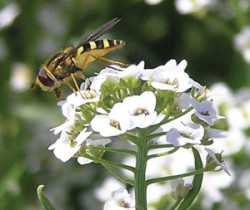Lettuce Growers’ MVB

Ramy Colfer hates to think what life would be like without the syrphid fly. An agricultural researcher who consults with growers farming more than 5,000 acres of organic lettuce and leafy vegetables on California’s Central Coast and Imperial Valley, Colfer envisions acre after acre being destroyed by lettuce aphids. “Some pests we don’t see very often,” he says, “but this is ubiquitous.”
Not only are the lettuce aphids ubiquitous, they are insidious. Unlike most pests that chomp away on the delectable leaves, lettuce aphids make their way into the innermost leaves of the lettuce head. That means contact insecticides aren’t effective, so growers resort to using systemic neonicitinoids such as imidacloprid (Admire, Bayer CropScience). But organic growers, such as those Colfer works with, can’t use such chemicals.
That’s where the syrphid fly comes in, says Colfer, an entomologist by training.
He hasn’t found anything, whether a chemical or biocontrol, that would eliminate aphid populations the way syrphid flies will. In fact, rather than try to limit aphids once they begin to colonize a lettuce field, Colfer will allow the aphid population to become established so that a strong syrphid fly population will likewise become established. “It’s a nice predator/prey cycle that occurs prior to harvest if everything’s going right,” he says.
Hover Flies
The syrphid flies, which are also called hover flies for the way they hover above flowers, have a symbiotic relationship with the aphids. The syrphid fly larvae need to feed on aphids to finish their development. And to the delight of organic growers, those young flies love to eat. “They have an extremely high predation rate,” says Colfer. “They are capable of completely controlling the pest, which is the excep-tion rather than the rule for biological control.”
Because the syrphid fly is so valuable, Colfer encourages them to populate his growers’ fields, and the best way to promote syrphid activity is through habitat. Once they complete the larval stage, the syrphid flies seek out pollen and nectar of certain flowering plants. For that reason, it’s a lot easier to attract syrphid flies to fields bordered by riparian habitat.
IPM MVP
One of the best plants for attracting syrphid flies is sweet alyssum, so that is what Colfer generally plants in his growers’ lettuce fields. Rather than mixing the flowering plants in the field, he opts to intercrop a few rows of alyssum within the lettuce fields. He has no studies to back it up, but believes these strips function better as in-sectaries than does scattering the sweet alyssum.
Such an approach is not without its costs, of course. Besides the expense of buying and planting the alyssum, Colfer loses about 3% of every field to insectary crops. But it’s worth it to attract the syrphid flies, which have become a critical part of his IPM program. “Without syrphid flies, you couldn’t produce lettuce year-round on the coast unless you had aphid-resistant varieties,” he says.
Europest Found A Home
The lettuce aphid is a relative newcomer to the U.S. It was first discovered in California exactly one decade ago (in 1998). It has long been the bane of European growers, and it is thought to have been brought to the U.S. on some radicchio seedlings. But however it got here, the lettuce aphid has made itself at home.
In 1998, just 100 acres or so were affected, but one year later, 100,000 acres — nearly 70% of Central Coast lettuce fields — had some level of infestation, according to Bill Chaney, a University of California (UC) Cooperative Extension farm advisor in Salinas. “In the most severely impacted fields,” said Chaney, “growers did not harvest a single head of lettuce.”
UC researchers went to work, testing numerous insecticide programs that could be used by conventional growers. But organic growers couldn’t avail themselves of such tools, and some shifted significant acreage out of California where the pest wasn’t present. Even today, without such biocontrols as syrphid flies, entomologist Ramy Colfer says coastal growers couldn’t produce organic lettuce year-round without resistant varieties.









